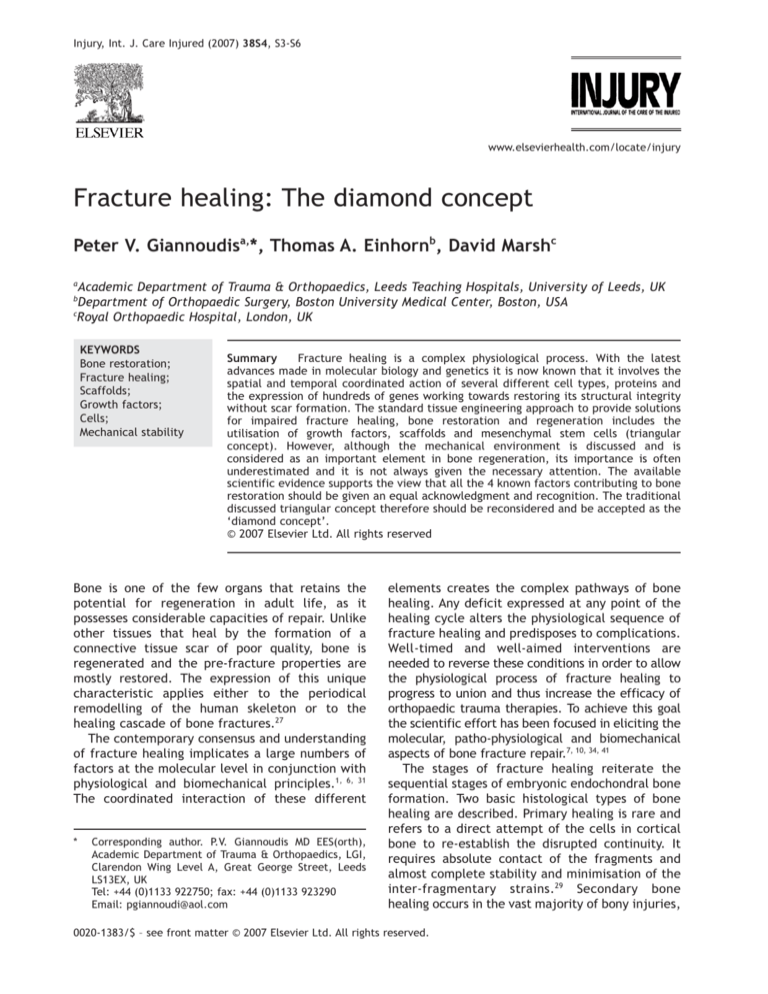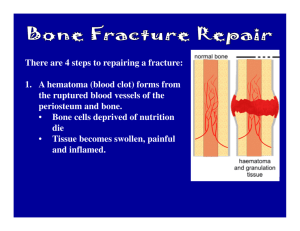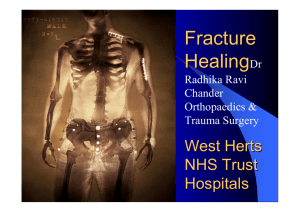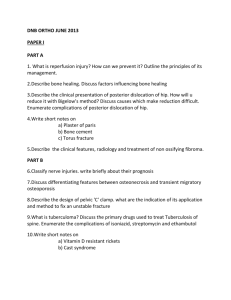
Injury, Int. J. Care Injured (2007) 38S4, S3-S6
www.elsevierhealth.com/locate/injury
Fracture healing: The diamond concept
Peter V. Giannoudisa,*, Thomas A. Einhornb, David Marshc
a
Academic Department of Trauma & Orthopaedics, Leeds Teaching Hospitals, University of Leeds, UK
Department of Orthopaedic Surgery, Boston University Medical Center, Boston, USA
c
Royal Orthopaedic Hospital, London, UK
b
KEYWORDS
Bone restoration;
Fracture healing;
Scaffolds;
Growth factors;
Cells;
Mechanical stability
Summary
Fracture healing is a complex physiological process. With the latest
advances made in molecular biology and genetics it is now known that it involves the
spatial and temporal coordinated action of several different cell types, proteins and
the expression of hundreds of genes working towards restoring its structural integrity
without scar formation. The standard tissue engineering approach to provide solutions
for impaired fracture healing, bone restoration and regeneration includes the
utilisation of growth factors, scaffolds and mesenchymal stem cells (triangular
concept). However, although the mechanical environment is discussed and is
considered as an important element in bone regeneration, its importance is often
underestimated and it is not always given the necessary attention. The available
scientific evidence supports the view that all the 4 known factors contributing to bone
restoration should be given an equal acknowledgment and recognition. The traditional
discussed triangular concept therefore should be reconsidered and be accepted as the
‘diamond concept’.
© 2007 Elsevier Ltd. All rights reserved
Bone is one of the few organs that retains the
potential for regeneration in adult life, as it
possesses considerable capacities of repair. Unlike
other tissues that heal by the formation of a
connective tissue scar of poor quality, bone is
regenerated and the pre-fracture properties are
mostly restored. The expression of this unique
characteristic applies either to the periodical
remodelling of the human skeleton or to the
healing cascade of bone fractures.27
The contemporary consensus and understanding
of fracture healing implicates a large numbers of
factors at the molecular level in conjunction with
physiological and biomechanical principles.1, 6, 31
The coordinated interaction of these different
*
Corresponding author. P.V. Giannoudis MD EES(orth),
Academic Department of Trauma & Orthopaedics, LGI,
Clarendon Wing Level A, Great George Street, Leeds
LS13EX, UK
Tel: +44 (0)1133 922750; fax: +44 (0)1133 923290
Email: pgiannoudi@aol.com
elements creates the complex pathways of bone
healing. Any deficit expressed at any point of the
healing cycle alters the physiological sequence of
fracture healing and predisposes to complications.
Well-timed and well-aimed interventions are
needed to reverse these conditions in order to allow
the physiological process of fracture healing to
progress to union and thus increase the efficacy of
orthopaedic trauma therapies. To achieve this goal
the scientific effort has been focused in eliciting the
molecular, patho-physiological and biomechanical
aspects of bone fracture repair.7, 10, 34, 41
The stages of fracture healing reiterate the
sequential stages of embryonic endochondral bone
formation. Two basic histological types of bone
healing are described. Primary healing is rare and
refers to a direct attempt of the cells in cortical
bone to re-establish the disrupted continuity. It
requires absolute contact of the fragments and
almost complete stability and minimisation of the
inter-fragmentary strains.29 Secondary bone
healing occurs in the vast majority of bony injuries,
0020-1383/$ – see front matter © 2007 Elsevier Ltd. All rights reserved.
S4
involves both intramembranous and endochondral
ossification and leads to callus formation. Committed osteoprogenitor cells of the periosteum
and undifferentiated multipotent mesenchymal
stem cells (MSCs) are activated. Callus is a
physiological reaction to inter-fragmentary
movement and requires the existence of residual
cell vitality and adequate blood flow.12, 29
In this cascade of events certain biologic
prerequisites have been identified. Many local and
systemic regulatory factors, cytokines and
hormones, as well as extracellular osteoconductive matrix are seen to interact with
several cell types. A vibrant cell population is a
mandatory first element for an unimpeded bone
repair process. Multipotent mesenchymal cells are
recruited at the fracture injury site or transferred
to it with the blood circulation. Bone marrow
response to a fracture includes an early
reorganization of the cellular population of the
bone marrow to areas of high and low cellular
density. The areas of high cellular density are
where the MSCs transformation to cells with an
osteoblastic phenotype occurs.5, 9, 18 Following the
identification and quantification of the osteogenic
role of bone marrow cells, genetically engineered
MSCs and differentiated osteoblasts have been
utilized to enhance fracture healing in a number
of in vitro and in vivo studies.8, 26, 35
The fracture hematoma has been proven to be
a source of signalling molecules (interleukins /
IL-1, IL-6, tumor necrosis factor-a / TNF-a,
fibroblast growth factor / FGF, insulin-like growth
factor / IGF, platelet-derived growth factor /
PDGF, vascular endothelial growth factor / VEGF,
and the transforming growth factor β / TGFβ
superfamily members) that may induce a cascade
of cellular events that initiate healing .4, 14 These
factors are secreted by endothelial cells, platelets,
macrophages, monocytes, but also by the mesenchymal stem cells, the chondrocytes, the osteocytes and the osteoblasts themselves.39, 40 The
investigation of the clinical use of these factors
has increased dramatically in the last decade. The
bone morphogenetic proteins (BMP-2 and BMP-7)
represent members of the TGFβ superfamily that
have been studied extensively. They have already
passed from the experimental level of testing to
the clinical practice and are established methods
of biological healing enhancement at areas of
delayed fracture healing or nonunions.13, 15, 16, 19, 21, 43
A third element of fracture healing is the extracellular matrix that provides the natural scaffold
for all the cellular events and interactions. Various
osteoconductive materials alone or usually
enriched with osteogenic and osteoinductive
P.V. Giannoudis et al.
factors have been used in the clinical practice.
Porous biomaterials such as allograft or xenograft
trabecular bone, demineralised bone matrix
(DBM)11, collagen, hydroxyapatite, polylactic or
polyglycolic acid, bioactive glasses and calciumbased ceramics have been used alone as bone void
fillers. They have also been combined with boneactive growth factors in an attempt to acheive a
maximal osteogenic effect.3, 28, 36, 38
These three biological prerequisites for fracture
healing enhancement have gained most of the
scientific attention. A triangular-shaped complex
of interactions between the potent osteogenic cell
populations, the osteoinductive stimulus and the
osteoconductive matrix scaffolds are often
analysed and extensively studied in the quest for
the optimal grafting material.
However, a fourth element, which is also mandatory for optimisation of bone fracture repair,
should also be taken under consideration and be
given the same recognition in terms of significance. Mechanical stability is a crucial factor for
bone healing, and is essential for the formation of
a callus that bridges the fracture site allowing
loads to be transmitted across the fracture line.
The progressive maturation of the fracture callus
from woven to lamellar bone depends on this
stability. Surgical interventions such as the
application of systems of internal or external
stabilisation are designed to improve stability of
fixation and therby enhance healing. Fracture
fixation methods have evolved from the era of
ORIF (open reduction and internal fixation) as
originally popularised by the AO30, to the contemporary concept of biologic fixation.25, 32, 37 Wolff’s
law44 describes the interaction of bone to the
applied stresses and its unique characteristic of
altering it’s mechanical properties according to
them. The application of this law to the clinical
setting of fracture healing together with the
interplay between parameters as implant rigidity,
relative or absolute fracture stability, fracture gap
size, and interfragmentary strain are all efforts to
express and compute the complex phenomena of
bone fracture repair.33 Relative stability and
maximal respect of the soft tissue envelope and
the vascularity around the fracture site are
considered essential. Scientific research has
quantified the essence of relative stability.
Splints, casts, intramedullary nails, external
fixators and locking plates, after open or mostly
closed reduction stabilise the fracture site by
minimizing the interfragmentary gap size, and
keeping the interfragmentary strain below 10%.2, 23
In the clinical setting of fracture fixation in
conjunction with bone grafting the mechanical
Fracture healing: the diamond concept
S5
material. An additional apex to the triangularshaped model of bone healing elements has to be
added to include the mechanical environment of
the fracture site. The result is a diamond shaped
concept of interaction (Figure 1).
Acknowledgements
This work is attributed to Academic Department of
Trauma and Orthopaedics, Leeds Teaching
Hospitals, University of Leeds, UK, Academic
Department of Trauma and Orthopaedics, Boston
University, Boston USA, Academic Department of
Trauma and Orthopaedics, Royal London Hospital,
London, UK.
Figure 1: The Diamond Model of Bone Fracture Healing
Interactions
stability necessary for optimal healing has not
been adequately studied. The general consensus is
that a certain load-shielding period has to be
achieved to protect the graft in its initial phase of
incorporation.20, 24
The role of mechanical stability in the
microenvironment of implanted grafts, scaffolds
or graft carriers is also essential and sometimes
overlooked. These properties vary greatly among
the various biomaterials and depend on their macro
and micro architecture, as well as porosity.22, 42
Significant parameters that differentiate the
indications of the different scaffolds and
biomaterials are the quality and density of the
host bone bed and the local biomechanical
demands of the fracture site (weight bearing limb
or not). Moreover, bone graft biomechanics evolve
parallel to the progress of its incorporation and to
callus remodelling. All these issues have formed
the bases for intense research efforts to improve
initial the mechanical properties of the available
biomaterials as well as to guarantee the presence
of a mechanically reliable construct throughout all
the remodelling phase of fracture healing. Recently,
3D porous polymer scaffolds with pore sizes ranging
from 150-500µm have shown optimal results related
to their biomechanical properties.17, 42
The operative or non-operative techniques of
fracture stabilisation, the utilised implants and
fixation devices, as well as the mechanical
properties of any grafting material all interact and
affect the fracture repair process. The mechanical
environment where any graft material is expected
to act has equal significance to the biologic
properties of the graft itself whether it is the gold
standard of autograft or synthetic grafting
Conflict of Interest
The authors state that they received nothing of
value with regard to this manuscript. There is no
conflict of interest.
References:
[1] Aaron RK, Ciombor DM, Wang S, Simon B. Clinical
biophysics: the promotion of skeletal repair by
physical forces. Ann N Y Acad Sci 2006; 1068 513-31
[2] Augat P, Margevicius K, Simon J, et al. Local tissue
properties in bone healing: influence of size and
stability of the osteotomy gap. J Orthop Res 1998; 16
475-81
[3] Babis GC, Soucacos PN. Bone scaffolds: the role of
mechanical stability and instrumentation. Injury 2005;
36 Suppl 4 S38-44
[4] Bolander ME. Regulation of fracture repair by growth
factors. Proc Soc Exp Biol Med 1992; 200 165-70
[5] Brighton CT, Hunt RM. Early histological and
ultrastructural changes in medullary fracture callus. J
Bone Joint Surg Am 1991; 73 832-47
[6] Carter DR, Beaupre GS, Giori NJ, Helms JA.
Mechanobiology of skeletal regeneration. Clin Orthop
Relat Res 1998; S41-55
[7] Chao EY, Inoue N. Biophysical stimulation of bone
fracture repair, regeneration and remodelling. Eur Cell
Mater 2003; 6 72-84; discussion -5
[8] Connolly JF. Clinical use of marrow osteoprogenitor
cells to stimulate osteogenesis. Clin Orthop Relat Res
1998; S257-66
[9] Connolly JF. Injectable bone marrow preparations to
stimulate osteogenic repair. Clin Orthop Relat Res
1995; 8-18
[10] Dimitriou R, Tsiridis E, Carr I, et al. The role of inhibitory molecules in fracture healing. Injury 2006; 37
Suppl 1 S20-9
[11] Dinopoulos HT, Giannoudis PV. Safety and efficacy of
use of demineralised bone matrix in orthopaedic and
trauma surgery. Expert Opin Drug Saf 2006; 5 847-66
[12] Einhorn TA. The cell and molecular biology of fracture
healing. Clin Orthop Relat Res 1998; S7-21
[13] Einhorn TA. Clinical applications of recombinant
human BMPs: early experience and future
S6
[14]
[15]
[16]
[17]
[18]
[19]
[20]
[21]
[22]
[23]
[24]
[25]
[26]
[27]
P.V. Giannoudis et al.
development. J Bone Joint Surg Am 2003; 85-A Suppl 3
82-8
Einhorn TA, Majeska RJ, Rush EB, et al. The expression
of cytokine activity by fracture callus. J Bone Miner
Res 1995; 10 1272-81
Friedlaender GE, Perry CR, Cole JD, et al. Osteogenic
protein-1 (bone morphogenetic protein-7) in the
treatment of tibial nonunions. J Bone Joint Surg Am
2001; 83-A Suppl 1 S151-8
Giannoudis PV, Tzioupis C. Clinical applications of
BMP-7: the UK perspective. Injury 2005; 36 Suppl 3
S47-50
Gil-Albarova J, Salinas AJ, Bueno-Lozano AL, et al. The
in vivo behaviour of a sol-gel glass and a glass-ceramic
during critical diaphyseal bone defects healing.
Biomaterials 2005; 26 4374-82
Gould SE, Rhee JM, Tay B-B, et al. Cellular contribution
of bone graft to fusion. J Orthop Res 2000; 18 920-7
Harwood PJ, Giannoudis PV. Application of bone
morphogenetic proteins in orthopaedic practice: their
efficacy and side effects. Expert Opin Drug Saf 2005; 4
75-89
Higgins TF, Dodds SD, Wolfe SW. A biomechanical
analysis of fixation of intra-articular distal radial
fractures with calcium-phosphate bone cement. J
Bone Joint Surg Am 2002; 84-A 1579-86
Kain MS, Einhorn TA. Recombinant human bone
morphogenetic proteins in the treatment of fractures.
Foot Ankle Clin 2005; 10 639-50, viii
Khan SN, Tomin E, Lane JM. Clinical applications of
bone graft substitutes. Orthop Clin North Am 2000; 31
389-98
Lacroix D, Prendergast PJ. A mechano-regulation model
for tissue differentiation during fracture healing: analysis
of gap size and loading. J Biomech 2002; 35 1163-71
Lanyon LE. Control of bone architecture by functional
load bearing. J Bone Miner Res 1992; 7 Suppl 2 S369-75
Leunig M, Hertel R, Siebenrock KA, et al. The evolution
of indirect reduction techniques for the treatment of
fractures. Clin Orthop Relat Res 2000; 375 7-14
Lieberman JR, Daluiski A, Stevenson S, et al. The
effect of regional gene therapy with bone
morphogenetic protein-2-producing bone-marrow cells
on the repair of segmental femoral defects in rats. J
Bone Joint Surg Am 1999; 81 905-17
Lyritis GP. The history of the walls of the Acropolis of
Athens and the natural history of secondary fracture
[28]
[29]
[30]
[31]
[32]
[33]
[34]
[35]
[36]
[37]
[38]
[39]
[40]
[41]
[42]
[43]
[44]
healing process. J Musculoskelet Neuronal Interact
2000; 1 1-3
Matziolis G, Tuischer J, Kasper G, et al. Simulation of
cell differentiation in fracture healing: mechanically
loaded composite scaffolds in a novel bioreactor
system. Tissue Eng 2006; 12 201-8
McKibbin B. The biology of fracture healing in long
bones. J Bone Joint Surg Br 1978; 60-B 150-62
Muller ME, Allgower M, Schneider R, Willenegger H.
Manual of internal fixation. 1991
Olsen BR, Reginato AM, Wang W. Bone development.
Annu Rev Cell Dev Biol 2000; 16 191-220
Perren SM. The concept of biological plating using the
limited contact-dynamic compression plate (LC-DCP).
Scientific background, design and application. Injury
1991; 22 Suppl 1 1-41
Perren SM. Physical and biological aspects of fracture
healing with special reference to internal fixation. Clin
Orthop Relat Res 1979; 138 175-96
Perren SM, Rahn BA. Biomechanics of fracture healing.
Can J Surg 1980; 23 228-32
Pountos I, Giannoudis PV. Biology of mesenchymal
stem cells. Injury 2005; 36 Suppl 3 S8-S12
Sammarco VJ, Chang L. Modern issues in bone graft
substitutes and advances in bone tissue technology.
Foot Ankle Clin 2002; 7 19-41
Sporer SM, Paprosky WG. Biologic fixation and bone
ingrowth. Orthop Clin North Am 2005; 36 105-11
Stylios G, Wan T, Giannoudis P. Present status and
future potential of enhancing bone healing using
nanotechnology. Injury 2007; 38 Suppl 1 S63-74
Tsiridis E, Giannoudis PV. Transcriptomics and
proteomics: advancing the understanding of genetic
basis of fracture healing. Injury 2006; 37 Suppl 1 S13-9
Tsiridis E, Upadhyay N, Giannoudis P. Molecular aspects
of fracture healing: which are the important
molecules? Injury 2007; 38 Suppl 1 S11-25
Tsiridis E, Upadhyay N, Giannoudis P. Molecular aspects
of fracture healing:Which are the important
molecules? Injury 2007; 38 Suppl 1 S11-25
Vaccaro AR. The role of the osteoconductive scaffold
in synthetic bone graft. Orthopedics 2002; 25 s571-8
Westerhuis RJ, van Bezooijen RL, Kloen P. Use of bone
morphogenetic proteins in traumatology. Injury 2005;
36 1405-12
Wolff J. Das gesetz der transformation der knochen.
Berlin: Verlag von Augsut Hirschwald 1892









